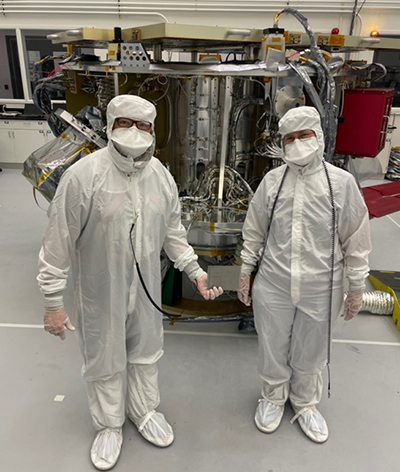The Solar Wind Experiment (SWE), developed at Los Alamos National Laboratory has been successfully integrated into NASA’s Interstellar Mapping and Acceleration Probe (IMAP) at the Johns Hopkins Applied Physics Laboratory (APL). SWE’s advanced electron-collecting technology will analyze solar wind electrons in real-time, measuring electron energies from 1 to 5000 electron volts. This will provide 3D insights into solar wind particles that will enhance researchers’ understanding of solar wind electron behavior and impacts, as well as advancing space weather monitoring in near real time.
The instrument team was led by Ruth Skoug, of the Space Science and Applications group at Los Alamos.
SWE collects solar wind electrons, from lower-energy “thermal” electrons that travel with the solar wind over several days, to higher-energy “suprathermal” electrons that reach Earth within hours. Using a fan-shaped field-of-view and a small 10mm aperture, SWE captures thousands of electrons per second in selected energy ranges and detects them after passing through a unique series of channel electron multipliers (CEMs) that amplify their signal for detailed analysis.
By graphing SWE’s data, scientists can create a full 3D distribution map of solar wind electrons, deepening their understanding of how these particles are generated by the Sun and how they travel outward, potentially reaching the heliopause boundary. These 3D data also reveal how solar electrons influence and interact with particles like energetic neutral atoms (ENAs), which either enter the solar system from interstellar space or are transformed as they travel back from the boundary. SWE’s data will enhance the overall understanding of solar particle dynamics across the solar system.
“It’s exciting to be able to continue solar wind electron studies into the next solar cycle, as well as to have real-time electron measurements for the first time,” Skoug said.

As part of IMAP’s instrument suite, SWE’s electron measurements will provide critical data on solar wind particle origin and behavior in space. SWE’s real-time data stream will support the IMAP Active Link for Real-Time (iALiRT) service for space weather forecasting, while its complete datasets will be stored onboard and transmitted to Earth multiple times weekly.
Like other IMAP instrument builds, SWE’s journey to integration involved a lot of late nights and travel for the team. Technical challenges did come about during the complex and sensitive flight model development, “but everybody stepped up to get all the details right,” Skoug said. “When issues came up, the whole team always came together with creative ideas that led us to the best solutions.”
Hannah Mohr, SWE Electrical Lead echoed Skoug’s appreciation of the high level of teamwork and expertise experienced as a member of team.
“It's great to work with a team that stays positive and focused even when technical challenges pop up, sometimes without an obvious path forward, and long hours in the lab go by faster because it's obvious that everyone cares about the success of the instrument,” Mohr said.
SWE’s integration into IMAP signifies a major advancement in the ability to study solar wind electron dynamics. By mapping electrons in 3D and observing their interactions across the solar system, SWE’s data will offer critical insights into the Sun’s impact on the space environment and bolster researchers’ understanding of particle behavior at the solar boundary.





